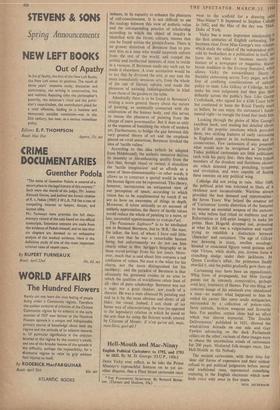Hell-Mouth and Mac-Ninny
English Political Caricature: to 1792, and 1793 to 1832. By M. D. George. (0.U.P., 140s.)
DOES Vicky ever reflect, as he inks the Prime Minister's reproachful features on to yet an- other disguise, that a Fleet Street cartoonist once * THE PASSIONATE SIGHTSEER. By Bernard Beren- son. (Thames and Hudson, 35s.)
went to the scaffold for a drawing called 'Mac-Ninny'? It happened to Stephen Colledge in 1682, and the Mac of the day was Duke of York.
Vicky has a more important relationship I° the first centuries of English cartooning. This becomes clear from Miss George's two volumes, which study the subject of the independent print; sold by booksellers as a publication in itself, and leave the art when it becomes merely eac feature of a newspaper or magazine. Beaver' brook tradition in the Evening Standard, which allows Vicky the extraordinary liberty c'f Socialist cartooning across Tory pages, sets 10
free of confining considerations of editorial policy or taste. Like Gillray or Colledge, he can make his own judgments and then glue theal defiantly across the public's face. Like George Cruikshank, who signed for a £100 Court bribe but continued to baste the Royal Family nnicb
as before, he can enjoy the cartoonist's funda- mental right—to mangle the hand that feeds him. Looking through the plates of Miss George's excellent book, and reading her detailed chron•
icle of the popular emotions which provoked them, two striking features of early cartooning in England appear in its recklessness and lls conservatism. Few cartoonists if any possessed what would now be recognised as 'principle.
Today political cartoonists are little politicians. each with his party line : then they were typical
members of the drunken and licentious elector- ate which detested pomp, preaching, tyrannY and revolution, and were capable of finding these enemies on any political wing.
Colledge did not swing in vain. After 1688, the political print was tolerated in libels of a virulence now inconceivable. Wartime always provided the best demand and opportunities: the Seven Years' War helped the amateur art of 'Caricatura' (comic distortion of the features) to become an essential weapon of the cartoon- ist, who before had relied on emblems and on Reformation or folk-print imagery to make his points. Here Hogarth dropped out, protesting at what he felt was a vulgarisation and vainly trying to establish a distinction between 'character' and caricature. The age of GillraY was dawning in crazy, swollen scatology: bloated or emaciated figures vomit guineas and rape Virtues, while skulls, pus, crowns form a crunching sludge under their jackboots. At Queen Caroline's affair, the printsmen finally overdid it, and the public gradually gave them up. Cartooning may have been an oppositionist, Whig form of propaganda, but Miss George points out its intensely conservative, perhaps even lazy, treatment of themes. For one thing, no concrete image of his misdeeds ever abandoned a man--no matter what happened to him he ended his career like some senile antiquarian, surrounded by a collection of poison-vials, farm animals, broken weapons and favourite hats. For another, certain ideas had an effect which was almost immortal. 'The Double Deliveraunce,' published in 1621, showed the wind-driven Armada on one side and Guy Fawkes advancing on the dark Parliament cellars on the other; variants of these images were to obsess the unconscious minds of cartoonists for 200 years. Medieval folk-images recur, like Hell-MoUth or the Nobody.
The ancient cartoonists, with their love for 'dear old' forms of expression and their violent refusal to put political judgments before moral and traditional ones, represented something enduring in the English electorate which now finds voice only once in five years.
NEAL ASCHERSON


















































 Previous page
Previous page